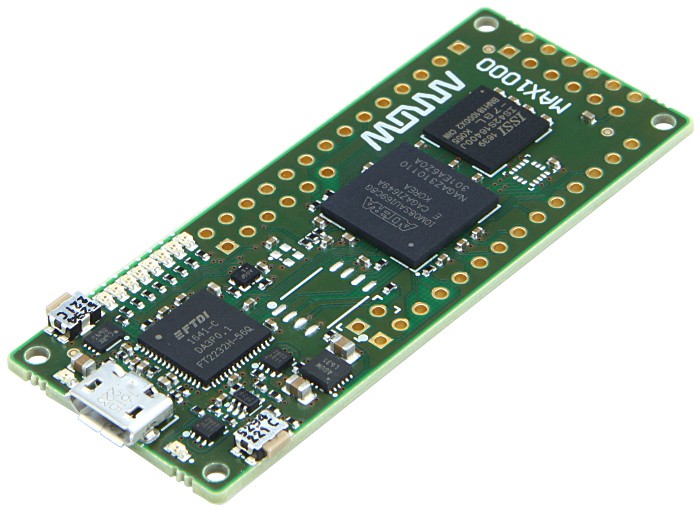Global distributor Arrow Electronics is making available a FPGA IoT Maker Board. Designed for end-to-end application development and optimised for cost, the MAX1000 board can be installed directly into a custom application or integrated on to a separate board
Intended for use by start-ups, universities or established equipment manufacturers who looking for a flexible, low cost FPGA platform for development, customised variants of the board are also available, according to Arrow.
The MAX1000 board can be installed directly into a custom application or integrated on to a completely separate board and is intended for use by start-ups, universities or established equipment manufacturers who looking for a flexible, low cost FPGA platform for development. Customised variants of the board are also available, according to Arrow.
At the board’s heart is a compact (11 x 11mm) Intel MAX10 FPGA with 8000 logic elements. This chip includes integrated flash memory, a 1Msample/s 12bit A/D converter for analogue signals and a 3.3V power supply. Other features include embedded SRAM, DSP blocks, instant-on within milliseconds, and the ability to implement Intel’s NIOS II soft core embedded processor to perform microcontroller tasks.
The board is equipped with an integrated Arrow USB-Blaster meaning that the FPGA can be programmed directly from a PC and debugged using the free of charge Intel Quartus Prime Lite software. As a result the MAX1000 is an easy to use plug and play solution. The USB-Blaster can also be integrated into the user’s own circuit if required.
The board’s power can be supplied as 5V from the USB port or via a separate pin. An Enpirion DC/DC converter with integrated coil then generates the 3.3V supply used on board. A MEMS oscillator provides the clock supply for the FPGA and the USB bridge. The low power, three axis acceleration sensor, which is also based on MEMS technology, can be used for position and motion detection, which are often required in IoT applications.
External SDRAM can be used for storage of application data or as memory for the NIOS II processor.
To provide an easy introduction into the use of FPGAs, a series of demo projects with NIOS II soft IP controllers are provided with the MAX1000. Eight configurable LEDs are available to display status and user inputs can be made via two buttons. A two-row connector, based on the Arduino MKR standard, and a PMOD plug provide flexible connectivity options including the ability to attach adaptor boards for wireless ICs or sensors.
Order a MAX1000 at Trenz Electronic Online Shop!
Link: www.arrow.com/de-de

